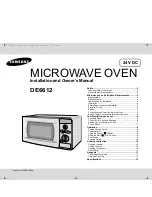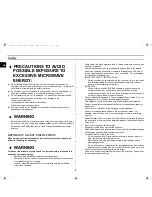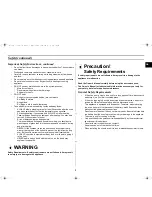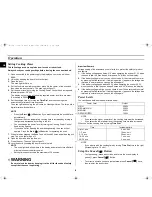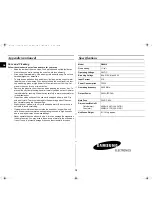
10
GB
Cooking Instruction
Cooking Utensils
Recommended Use
•
Glass and glass-ceramic bowls and dishes — Use for heating or
cooking.
•
Microwave browning dish — Use to brown the exterior of small items
such as steaks, chops, or pancakes. Follow the directions provided with
your browning dish.
•
Microwavable plastic wrap — Use to retain steam. Leave a small
opening for some steam to escape and avoid placing it directly on the
food.
•
Wax paper — Use as a cover to prevent spattering.
•
Paper towels and napkins — Use for short-term heating and covering;
they absorb excess moisture and prevent spattering. Do not use recycled
paper towels, which may contain metal and can catch fire.
•
Paper plates and cups — Use for short-term heating at low
temperatures. Do not use recycled paper, which may contain metal and
can catch fire.
•
Thermometers — Use only those labeled “Microwave Safe” and follow all
directions. Check the food in several places. Conventional thermometers
may be used once the food has been removed from the oven.
Limited Use
•
Aluminum foil — Use narrow strips of foil to prevent overcooking of
exposed areas. Using too much foil can damage your oven, so be careful.
•
Ceramic, porcelain, and stoneware — Use these if they are labeled
“Microwave Safe.” If they are not labeled, test them to make sure they can
be used safely. Never use dishes with metallic trim.
•
Plastic — Use only if labeled “Microwave Safe.” Other plastics can melt.
•
Straw, wicker, and wood — Use only for short-term heating, as they can
be flammable.
Not Recommended
•
Glass jars and bottles — Regular glass is too thin to be used in a
microwave, and can shatter.
•
Paper bags — These are a fire hazard, except for popcorn bags that are
designed for microwave use.
•
Styrofoam plates and cups — These can melt and leave an unhealthy
residue on food.
•
Plastic storage and food containers — Containers such as margarine
tubs can melt in the microwave.
•
Metal utensils — These can damage your oven. Remove all metal before
cooking.
Testing Utensils
If you are not sure whether a dish is microwave-safe or not, you can perform this
test:
1.
Fill a 1 cup glass measuring cup with water and put it inside your oven, next to
the dish you want to test.
2.
Press the Start(
) +30 s button 4 times to heat for two minutes.
The water should be warm and the dish you are testing should be cool. If the dish
is warm, then it is absorbing microwave energy and is not acceptable for use in the
microwave.
Cooking Techniques
Stirring
Stir foods such as casseroles and vegetables while cooking to distribute heat
evenly. Food at the outside of the dish absorbs more energy and heats more
quickly, so stir from the outside to the center. The oven will turn off when you open
the door to stir your food.
Arrangement
Arrange unevenly shaped foods, such as chicken pieces or chops, with the
thicker, meatier parts toward the outside of the turntable where they receive more
microwave energy. To prevent overcooking, place thin or delicate parts toward the
center of the turntable.
Shielding
Shield food with narrow strips of aluminum foil to prevent overcooking. Areas that
need shielding include poultry wing-tips, the ends of poultry legs, and corners of
square baking dishes. Use only small amounts of aluminum foil. Larger amounts
can damage your oven.
Turning
Turn foods over midway through cooking to expose all parts to microwave energy.
Standing
Foods cooked in the microwave build up internal heat and continue to cook for a
few minutes after the oven stops. Let foods stand to complete cooking, especially
foods such as roasts and whole vegetables. Roasts need this time to complete
cooking in the center without overcooking the outer areas. All liquids, such as soup
or hot chocolate, should be shaken or stirred when cooking is complete. Let liquids
stand a moment before serving. When heating baby food, stir well and test the
temperature before serving.
!

